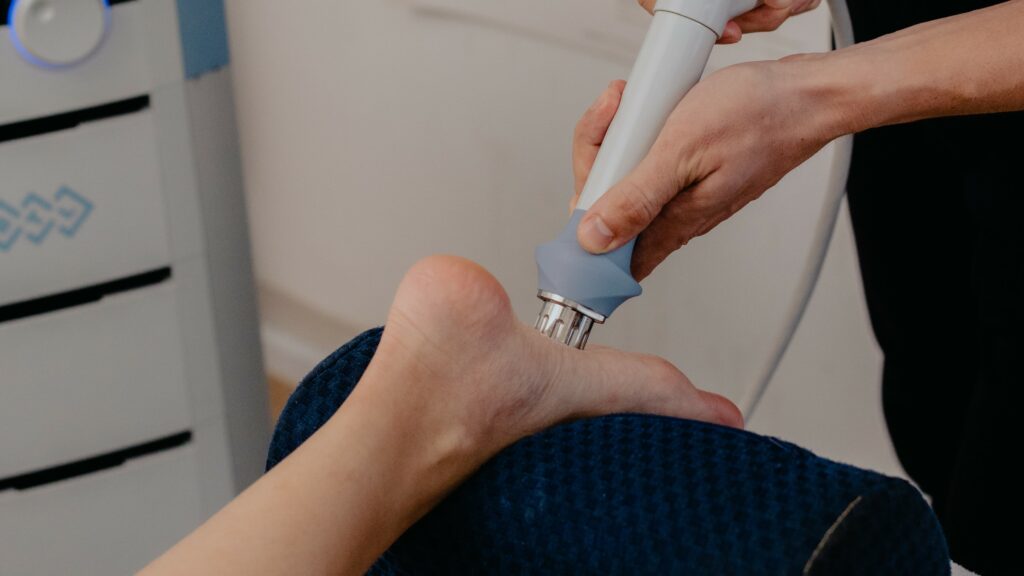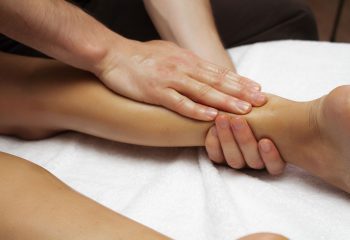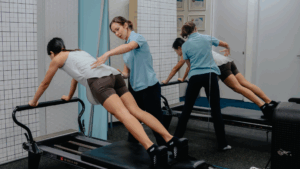As a dancer, your ankles play a critical role in your ability to perform intricate movements, leaps, and balances. Unfortunately, they are also highly susceptible to injuries like sprains, strains, and fractures due to the physical demands of dance. This guide will explore how to prevent ankle injuries, recognise whether you’re dealing with a sprain or a broken ankle, and the best steps for recovery.
At City Osteopathy & Physiotherapy, our physiotherapists have extensive experience treating dance-related injuries— and some even have a personal background as dancers, giving them unique insight into your needs.
Why dancers are prone to ankle pain
Dancers place significant and repetitive strain on their ankles through high-impact movements, jumps, and prolonged time spent in positions like pointe or demi-pointe. Over time, this stress can lead to various ankle issues, including inner ankle pain, reduced mobility, and inflammation.
Inadequate warm-ups, improper technique, or insufficient rest can further increase the risk of injury. Without strengthening exercises or preventative care, dancers may experience chronic pain or more severe injuries that could take them out of practice or performance altogether.
By incorporating regular ankle injury prevention exercises and addressing any signs of strain early, you can avoid long-term issues and maintain optimal performance.
Understanding the types of ankle pain
Ankle pain can affect different areas of the joint, and identifying the location and nature of the pain is essential for determining the underlying cause. Dancers, in particular, may experience various types of ankle pain due to the repetitive and high-impact movements their profession demands. Here’s a breakdown of the most common types of ankle pain:
Inner ankle pain
Pain on the inside of the ankle often involves the posterior tibial tendon, which supports the arch of the foot. This type of pain can be caused by:
- Overuse injuries: Repeated stress on the tendon from dance movements.
- Tendonitis: Inflammation of the posterior tibial tendon due to strain or improper foot alignment.
- Flat feet: Reduced arch support can put additional strain on the inner ankle.
If left untreated, inner ankle pain can worsen, leading to more serious issues like posterior tibial tendon dysfunction. Early intervention with physiotherapy can help address the root cause and alleviate symptoms.
Outer ankle pain
Pain on the outside of the ankle is often associated with lateral ligament injuries, such as sprains. Common causes include:
- Rolling or twisting the ankle during jumps or landings.
- Weakness in the ligaments from previous injuries.
Outer ankle pain can also result from peroneal tendonitis, which occurs when the tendons that run along the outside of the ankle become inflamed.
Front of the ankle pain
Pain at the front of the ankle, or anterior ankle pain, can result from:
- Impingement syndrome, where soft tissues are pinched during ankle movements.
- Overuse injuries from repetitive dorsiflexion, such as landing from a leap or plié.
Achilles tendon pain
Pain at the back of the ankle typically involves the Achilles tendon. This type of pain is often due to:
- Tendonitis from overuse or poor landing mechanics.
- Tight calf muscles, which place extra strain on the Achilles tendon.
Generalised ankle pain
If the pain is not localised, it may be due to conditions such as arthritis or general inflammation from overuse. Physiotherapy can help by identifying the cause and creating a customised treatment plan.
Regardless of the type of ankle pain, addressing the issue promptly is essential to prevent further complications.
Sprained vs broken ankle: How to tell the difference
Sprained ankle symptoms
A sprain occurs when the ligaments supporting the ankle are overstretched or torn. Common symptoms include:
- Pain and tenderness, often around the outer ankle
- Swelling that can develop quickly
- Bruising or discolouration
- Limited range of motion or difficulty walking
Sprains can vary in severity, from mild stretching of the ligaments to complete tears. Early assessment is crucial to determine the appropriate treatment.
Broken ankle symptoms
An ankle fracture involves a break in one or more of the bones in the ankle joint. Symptoms are usually more severe and may include:
- Sharp, intense pain immediately after the injury
- Visible deformity or misalignment of the ankle
- Swelling and bruising extending up the leg
- Inability to bear any weight
If you’re unsure whether it’s a sprain or a fracture, seek medical attention promptly. Our physiotherapy team can perform a thorough assessment and ensure you receive the appropriate care to promote healing.
How to heal a sprained ankle fast with the right steps
Recovering from a sprain requires a combination of rest, support, and gradual rehabilitation.
The RICE protocol for a sprained ankle
The first step after a sprain is following the RICE protocol:
- Rest: Avoid putting weight on the ankle to prevent further damage.
- Ice: Apply a cold pack to reduce swelling and inflammation.
- Compression: Use a bandage or kinesiology tape for ankle sprains to stabilise the joint.
- Elevation: Keep the ankle raised to minimise swelling.
Additional recovery tools
- Ankle guard for sprains: These provide added support during the healing process.
- Spray for sprained ankles: Anti-inflammatory sprays can help ease pain and swelling.
Our physiotherapists will also guide you through a series of tailored ankle sprain exercises to rebuild strength and mobility.
How to heal a sprained ankle fast with the right steps
Healing a sprained ankle quickly requires proper care, rest, and gradual rehabilitation. Below, we address common concerns and outline effective strategies to speed up recovery, prevent further injury, and regain strength and mobility.
Can a sprained ankle heal overnight?
While it’s tempting to hope for an overnight recovery, the reality is that a sprained ankle requires time and attention to heal. The severity of the sprain determines the recovery period:
- Mild sprains: May heal in 1-2 weeks with proper care.
- Moderate to severe sprains: Could take several weeks or months.
Though a full recovery cannot happen overnight, following the RICE protocol (Rest, Ice, Compression, Elevation) immediately after the injury can significantly reduce swelling and pain, setting the foundation for faster healing.
Ankle sprain exercises
Once the initial pain and swelling have subsided, starting targeted exercises can help restore strength and mobility. Recommended exercises include:
- Toe raises: Strengthen the calves and improve balance.
- Ankle circles: Promote flexibility and reduce stiffness.
- Resistance band stretches: Build strength in the ankle and surrounding muscles.
Our physiotherapists can design a personalised exercise plan to ensure you progress safely and effectively.
Ankle support for sprain
Using proper ankle support during recovery is crucial for preventing re-injury. Supportive devices, such as braces, help stabilise the joint and reduce strain on the ligaments. Your physiotherapist can recommend the most suitable option for your specific condition or advise on how to use these supports correctly & effectively.
Ankle guard for sprain
An ankle guard provides additional protection by immobilising the joint during recovery. It is especially useful for moderate to severe sprains or when resuming light activities. Look for an adjustable, comfortable design to ensure optimal support.
Kinesiology tape for ankle sprain
Kinesiology tape is an effective tool for reducing swelling, improving circulation, and providing gentle support to the injured area. When applied correctly, it can:
- Alleviate pain by reducing pressure on the injured ligaments.
- Stabilise the ankle during movements.
Our physiotherapists are skilled in applying kinesiology tape and can teach you how to use it effectively.
Spray for sprained ankle
Topical sprays, often containing anti-inflammatory or cooling agents, can provide temporary relief from pain and swelling. They are a convenient addition to your recovery toolkit, especially in the early stages of healing.
By combining these methods with professional physiotherapy guidance, you can ensure a smooth and effective recovery from your sprained ankle. At City Osteopathy & Physiotherapy, our team is here to support you every step of the way, offering expert care tailored to your needs.
How ankle strengthening exercises can prevent future injuries
Preventative care is just as important as treating injuries. Incorporating regular ankle strengthening exercises can reduce your risk of injury and improve your overall performance.
Essential ankle strengthening exercises for dancers
- Resistance band stretches: Strengthen stabilising muscles with controlled movements.
- Heel raises: Build calf and ankle strength by lifting onto your toes and lowering back down slowly.
- Balance drills: Practice standing on one leg or incorporating wobble boards to improve stability and proprioception.
- Toe curls and taps: Strengthen the smaller muscles in your feet and ankles by picking up small objects with your toes or tapping them on the floor.
When performed regularly and with proper form, these exercises can improve your ankle’s strength, flexibility, and resilience.
Why dancers should prioritise physiotherapy
For dancers, their body is their instrument, and maintaining its optimal function is vital for performance and longevity. Physiotherapy plays a key role in injury prevention and recovery, especially for high-risk joints like the ankle.
Preventing injuries with ankle strengthening exercises
Ankle strengthening exercises are essential for dancers to build resilience against the strains of their profession. Regularly practicing targeted exercises, such as single-leg balances, resistance band stretches, and calf raises, helps:
- Improve stability during complex movements.
- Enhance joint support, reducing the risk of sprains.
- Boost performance by allowing for better control and balance.
Physiotherapists can guide dancers through tailored exercise routines to strengthen their ankles while maintaining flexibility and agility.
Recovering quickly and safely from injuries
Injuries are a reality for dancers, but physiotherapy ensures that recovery is both efficient and complete. Addressing issues like ankle sprains or overuse injuries promptly prevents long-term complications and helps dancers return to the stage with confidence.
Optimising performance through preventative care
Physiotherapy isn’t just for treating injuries—it’s also a powerful tool for prevention. Regular consultations help identify weaknesses or imbalances, which can be corrected before they lead to injury. By incorporating ankle injury prevention exercises into their routine, dancers can perform at their best without fear of setbacks.
At City Osteopathy & Physiotherapy, our team of experienced physiotherapists—some even with personal backgrounds in dance—understand the unique demands of a dancer’s body. With their expertise, dancers can ensure their ankles remain strong, stable, and ready to meet the challenges of their art.
Why choose City Osteopathy & Physiotherapy?
At City Osteopathy & Physiotherapy, we are committed to helping dancers stay healthy and injury-free. Our team of physiotherapists combines clinical expertise with personal experience as dancers to offer unparalleled care. From treating ankle pains to designing preventative programs, we’re here to support your performance and well-being.
We provide tailored, focused treatments designed to meet the unique needs of every patient. Our expert team combines advanced techniques from physiotherapy, osteopathy, and other complementary practices, delivering holistic care that addresses injuries, boosts performance, and prevents future issues. By fostering cross-disciplinary collaboration, our practitioners continuously enhance their skills, ensuring patients benefit from a well-rounded, effective approach to recovery and wellness.
Our team is known for their empathy and understanding, with many practitioners bringing personal experience as dancers or actively pursuing their own hobbies and passions. This insight allows us to connect deeply with patients, recognising the importance of peak performance and timely recovery. Whether you’re a dancer aiming to stay injury-free or an individual recovering from an ankle issue, we are committed to helping you achieve your goals with care and expertise.
Highly rated by patients for delivering exceptional results, City Osteopathy & Physiotherapy is more than a healthcare provider—we’re a trusted partner in your wellness journey. With a blend of technical expertise and compassionate support, we ensure you’re equipped to move forward confidently and perform at your best.
Don’t let an ankle injury hold you back. Book a consultation with our team today and take the first step toward healthier, stronger ankles.










